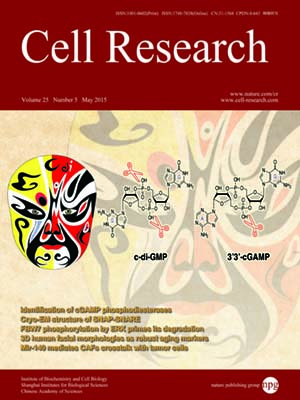
Volume 25, No 5, May 2015
ISSN: 1001-0602
EISSN: 1748-7838 2018
impact factor 17.848*
(Clarivate Analytics, 2019)
Volume 25 Issue 5, May 2015: 574-581
ORIGINAL ARTICLES
Three-dimensional human facial morphologies as robust aging markers
Weiyang Chen1,2, Wei Qian1,2, Gang Wu1, Weizhong Chen1,2, Bo Xian1, Xingwei Chen1,2, Yaqiang Cao1,2, Christopher D Green1, Fanghong Zhao3, Kun Tang1 and Jing-Dong J Han1,4
1Chinese Academy of Sciences Key Laboratory of Computational Biology, Chinese Academy of Sciences-Max Planck Partner Institute for Computational Biology, Shanghai Institutes for Biological Sciences, Chinese Academy of Sciences, 320 Yue Yang Road, Shanghai 200031, China
2University of Chinese Academy of Sciences, Beijing 100049, China
3Beijing Centers for Diseases Control and Prevention (CDC) & Centers for Preventive Medical Research, Beijing 100013, China
4Collaborative Innovation Center for Genetics and Developmental Biology, Fudan University, Shanghai 200433, China
Correspondence: Jing-Dong J Han(jdhan@picb.ac.cn)
Aging is associated with many complex diseases. Reliable prediction of the aging process is important for assessing the risks of aging-associated diseases. However, despite intense research, so far there is no reliable aging marker. Here we addressed this problem by examining whether human 3D facial imaging features could be used as reliable aging markers. We collected > 300 3D human facial images and blood profiles well-distributed across ages of 17 to 77 years. By analyzing the morphological profiles, we generated the first comprehensive map of the aging human facial phenome. We identified quantitative facial features, such as eye slopes, highly associated with age. We constructed a robust age predictor and found that on average people of the same chronological age differ by ± 6 years in facial age, with the deviations increasing after age 40. Using this predictor, we identified slow and fast agers that are significantly supported by levels of health indicators. Despite a close relationship between facial morphological features and health indicators in the blood, facial features are more reliable aging biomarkers than blood profiles and can better reflect the general health status than chronological age.
10.1038/cr.2015.36
FULL TEXT | PDF
Browse 2155


